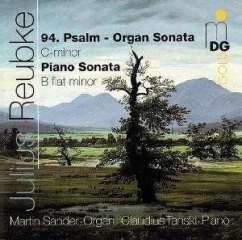Julius Reubke - Klaviersonate - Orgelsonate (1988)
Julius Reubke - Klaviersonate - Orgelsonate (1988)

1 Große Sonate für Pianoforte zu zwei Händen, b-moll - Allegro ...... 13:38 2 Andante sostenuto 7:28 3 Allegro assai 8:43 4 Große Sonate für die Orgel (der 94. Psalm), c-moll - Grave - ...... 11:09 5 Adagio 14:07 6 Allegro 6:38 Martin Sander - organ Claudius Tanski – piano
Reubke received his early musical training from Hermann Bonicke in Quedlinburg. Among other works, he produced his =Trio in E flat= during this time. He entered the Berlin Conservatory in 1851, where he studied piano with Kullak and composition with Bernhard Marx. He was considered the school's most gifted student and composed works fluently written in the keyboard style of Chopin during this time. After a short period of teaching piano at the conservatory, he went to Weimar to study with Liszt, where he became one of Liszt's favorite pupils. His two most important works, written in 1857, were the Piano Sonata in B flat minor and the Organ Sonata in C minor. Both works were admired by members of the Weimar circle, and Liszt regarded Reubke as a composer of promise. He moved to Dresden in 1857 and joined the Dresden Tonkunstlerverein, participating as a pianist in their concerts. He died in June of that year. His organ sonata, an instrumental setting of a psalm text, is considered one of the truest manifestations of Romantic thought, and it represents one of the high points of nineteenth century organ literature. His early death left his considerable promise unfulfilled. --- Lynn Vought, Rovi
The Sonata on the 94th Psalm in C minor based on the text of Psalm 94. Reubke composed the sonata while he was studying piano and composition in Weimar with Franz Liszt, and living at the Altenburg house. He composed it at the same time as his other large work, the Piano Sonata in B-flat minor, and finished it in April 1857. The 94th Psalm Sonata is considered to be inspired by Liszt's Fantasy and Fugue on the chorale Ad nos, ad salutarem undam, Piano Sonata, symphonic poems and Wagner's operas. It is nonetheless a very individual work composed well for the organ, requiring very advanced pedal technique - which testifies to Reubke's much greater ability at the organ than Liszt - and a resourceful use of all the organ's departments.
The Piano Sonata in B-flat minor is a work written December 1856 and March 1857. Although it remains very obscure and is little performed (unlike the composer's Sonata on the 94th Psalm for organ), it combines the Lisztian technique of thematic transformation, colourful harmonies, virtuosic piano writing and a wide array of characters and sentiments. The work opens with an Allegro maestoso, characterised by a dramatic, rising forte first subject. This rising motif (a minor semitone followed by a major third jump), is a significant theme of the movement, recalled at various points throughout (including the cadenza-like passagework). The main theme is built over a chordal structure of i, bII6, viio7, i4-3, v, and VI6/4. The work has other, similarly interesting modulations, presented as undecorated chordal series. The second theme, marked Quasi Recitativo is written in a free and vocal style. Its melancholy second subject, in the distant key of E major, recalls something of Reubke's own sadly short life.---wikipedia








